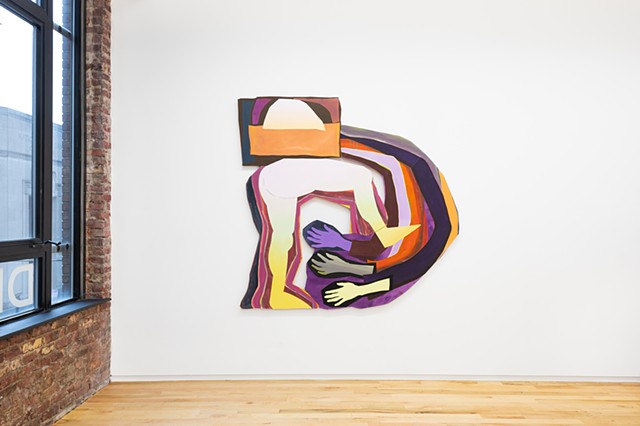2019-2024
DIMIN is pleased to present a new body of work by Justine Hill titled "Omphalos". In this exhibition, Hill expands her practice of landscape building by posing questions about anthropomorphic form, storytelling, scale and position.
Hill oscillates between a human and a cosmic scale; from painting a single waterfall, to the solar system or a domestic arrangement of furniture, she explores how we position the human body and mind in relation to objects in our natural and fantastical worlds. To borrow a term Lee Bontecou used to describe her soot drawings, Hill’s “worldscapes” are an investigation to better understand our place.
The circular-disk-shape, most commonly identified as the sun, became the subject of Hill’s landscapes. A recent trip to Egypt offered the artist a chance to explore an ancient civilization known for their imagery and worship of cosmic bodies. Amidst the unparalleled visual density in the tombs and temples, it was the night sky covering the ceiling of every tomb in the Valley of the Kings that resonated with the artist. In each iteration, there was the form of an elongated woman stretched over the sarcophagus. This was Nut, goddess of the sky and protector of the dead. Eternally bent over the earth, she swallows the sun each evening and gives birth to it each day.
The influence of the depiction of the Goddess Nut (ca 1200 BC) can be seen throughout the exhibition. The “Bend” paintings, each composed of three panels, show a form leaning forward with their legs on one side, their arms on the other and a body as the connector. The “Bust” paintings rotate the “Bend” form 90 degrees. They depict a torso, shoulders to navel, with an exposed chest cavity filled with a striated, radiating disk—the unmistakable nucleus of all things. The remainder of the paintings in "Omphalos" are simplified to focus only on one body, the circle. Stars have always been a symbol of time—ancient bodies floating in a vast emptiness. Poets describe them with words such as breathing, blinking, blushing; words that humanize these molten rocks. Humanity’s art and language as frequently dressed the heavenly bodies in our image, and vise versa.
While Hill’s new work is noticeably steeped in mythology, much of the inspiration for "Omphalos" is rooted in contemporary literature. The title "Omphalos," meaning “center” or “navel of the earth” in Greek mythology, is borrowed from one of Ted Chiang’s short stories in the collection “Exhalation” from 2019. Chiang’s "Omphalos" raises the question: which better exhibits proof of a creator, a navel or no navel? Chiang, like so many other Speculative Fiction writers, asks the abstract questions about origin and purpose using grand quests, time travel, and quarrels with gods to add perspective upon humanity’s position in the world. Words and images are tools that build cultures, create hierarchies, and dictate the rules of pious living.
It would be logical to connect the story of Nut to the Goddess Movement of the 1960s, but instead Hill’s inclination is to lean to the cyborg. The cyborg was Donna Haraway’s proposal out of dualisms such as female/male, human/animal, organism/machine, and perhaps origin stories as “the cyborg would not recognize the Garden of Eden; it is not made of mud and cannot dream of returning to dust” (Donna Haraway “A Cyborg Manifesto,” 1985). Cyborgs have indeed become “ubiquitous and invisible” as Haraway predicted. Time has proven that subtle adaptations get overlooked and forgotten, is it only when the difference is still visible that questions are raised.
Over the years Hill’s paintings have absorbed more and more human characteristics and appendages, culminating in her most humanoid looking body of work.
